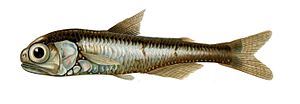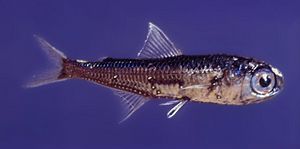Lanternfish facts for kids
Quick facts for kids Lanternfish |
|
|---|---|
 |
|
| Myctophum punctatum | |
| Scientific classification |
|
| Kingdom: | Animalia |
| Phylum: | Chordata |
| Class: | Actinopterygii |
| Order: | Myctophiformes |
| Family: | Myctophidae T. N. Gill, 1893 |
| Genera | |
|
Benthosema |
|
Lanternfish are amazing deep-sea fish known for their special ability to glow in the dark! They belong to a large family called Myctophidae. There are 246 different types, or species, of lanternfish found in oceans all over the world.
These fish get their name because they use bioluminescence, which means they can make their own light. They are one of the most common animals with backbones (vertebrates) in the ocean. Scientists believe that lanternfish make up about 65% of all the fish living in the deep sea. This means they are a huge part of the ocean's living creatures!
Contents
What Do Lanternfish Look Like?
Lanternfish are usually small, growing from about 2 to 30 centimeters (1 to 12 inches) long. Most are shorter than 15 centimeters (6 inches). They have a thin, flat body covered in small, shiny scales. Their heads are large and rounded, with big eyes that help them see in the dim ocean. They have a wide mouth filled with tiny teeth.
Their fins are generally small. They have a single fin on their back, a forked tail fin, and a small, fleshy fin called an adipose fin. Most lanternfish also have a gas bladder, which helps them control their depth in the water.
Their Special Lights
The most amazing thing about lanternfish is their photophores. These are special organs that produce light. Almost all lanternfish have these lights, arranged in pairs along their bodies and heads. Some even have special lights near their eyes, like "headlights"!
These photophores glow with a soft blue, green, or yellow light. The pattern of these lights is unique for each species, like a secret code. In some types of lanternfish, the light patterns are different for males and females. For example, males might have glowing patches above their tail, while females have them below.
Shallow-living lanternfish often look shiny blue, green, or silver. But those that live deeper in the ocean are usually dark brown or black.
Where Do Lanternfish Live and What Do They Do?
Lanternfish are famous for their daily journeys up and down in the ocean. This is called diel vertical migration. During the day, most species stay deep in the ocean, between 300 and 1500 meters (1,000 to 5,000 feet) down. It's very dark there.
As the sun sets, these fish start to swim up towards the surface, reaching depths of 10 to 100 meters (30 to 300 feet). They do this to find food, like tiny animals called zooplankton. They also move up to avoid predators that might be hunting them in the deeper waters. After a night of feeding near the surface, they swim back down to the dark depths before daybreak.
Many lanternfish stay near the coast, swimming together in large groups over the continental slope. Different species often live at different depths. This helps them avoid competing for food and space.
How They Use Their Lights
The unique patterns of lights on lanternfish are like their own language. Scientists think these lights help them communicate with each other, especially when they are swimming in groups or looking for a mate.
Their lights also help them hide from predators. This trick is called counterillumination. Lanternfish can change the brightness of their blue light to match the dim light coming from above. This makes their outline disappear when seen from below, so predators can't spot them easily.
Lanternfish in the Food Web
Lanternfish are a very important part of the ocean's food chain. Many other marine animals rely on them for food. These include:
- Large whales and dolphins
- Big pelagic fish like salmon, tuna, and sharks
- Other deep-sea fish
- Pinnipeds (like seals and sea lions)
- Sea birds, especially penguins
- Large squid like the jumbo squid
Sadly, lanternfish have also been found to eat small pieces of plastic that pollute the ocean. Scientists have found more than 80 pieces of plastic in the gut of one lanternfish!
The Deep Scattering Layer
During World War II, people using new Sonar technology noticed something strange. Their sonar showed what looked like a false sea floor about 300–500 meters (1,000–1,600 feet) deep during the day. At night, this "false bottom" moved closer to the surface.
Scientists later discovered that this was caused by millions of marine animals, especially small deep-sea fish like lanternfish. These fish have swimbladders filled with gas, which reflect the sonar waves. When the fish migrate up at night to feed, the "false bottom" moves up with them. This is why it's called the deep scattering layer.
Lanternfish are a huge part of this layer because there are so many of them. Their total weight in the ocean is estimated to be 550–660 million metric tonnes. This is several times more than all the fish caught by humans around the world each year!
Images for kids
See also
 In Spanish: Peces linterna para niños
In Spanish: Peces linterna para niños



